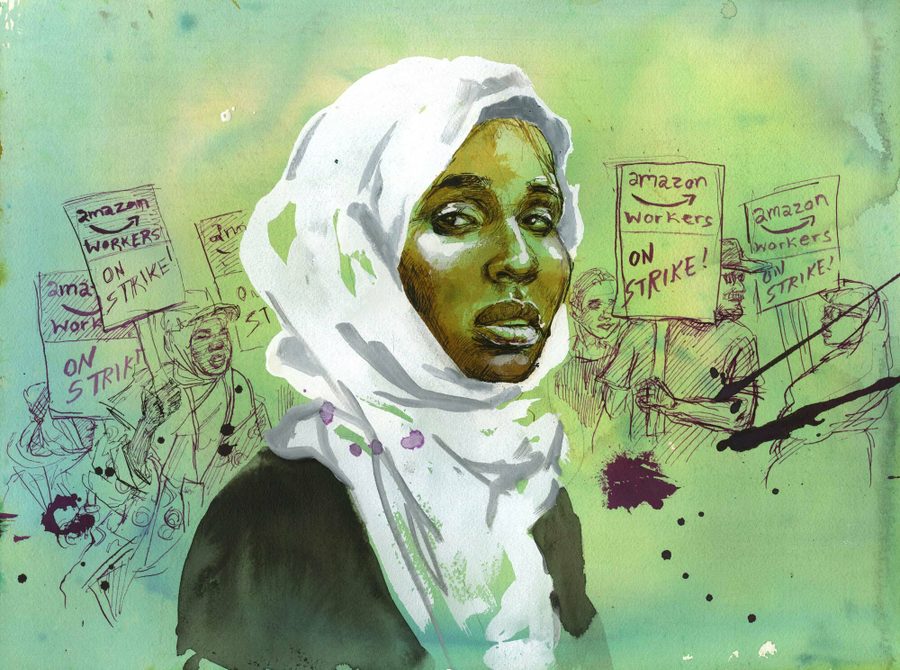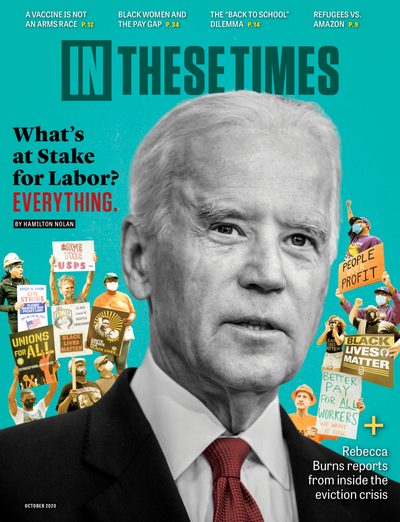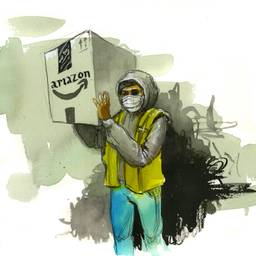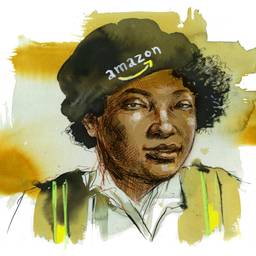Meet the Warehouse Worker Who Took On Amazon Over Inhumane Conditions and Harassment
Hibaq Mohamed organized her community in a fight against Amazon, protesting working conditions at a fulfillment center with one of the highest rates of injury.
Michelle Chen and Molly Crabapple

This article is part of a series on Amazon workers produced in partnership with the Economic Hardship Reporting Project.
Hibaq Mohamed has worked for Amazon nearly as long as she’s been in the United States. In 2016, the twenty-something Somali immigrant landed in Minnesota by way of a refugee camp, joining one of the largest East African communities in the country. She soon joined the legion of workers who fuel the state’s main Amazon facility, the MSP1 fulfillment center in Shakopee, near the Twin Cities.
“This was my first job,” Mohamed says. “They were hiring workers … East African and people like me. [These workers] didn’t have a lot of experience, they don’t know a lot.”
The Shakopee facility employs roughly 1,000 workers to execute Amazon’s highly mechanized work regimen every day, packing orders at a frenzied rate of around 250 units per hour. While items zip down a conveyor belt, the workers are monitored, through an automated system, to track their speed and any errors that might damage their performance ratings.
On top of the pressure to meet quotas, Mohamed says management decided to “fire a crazy number of workers” shortly after she started working there. “And they are not telling us what they fired them for,” she recalls. She says the workers were immigrants who did not speak English fluently.
Though Amazon says these were seasonal hires — and were therefore dismissed once their temporary stints ended, the seeming lack of transparency troubled Mohamed. “I feel like this was unfair,” she says.
Around 2017, Mohamed and other East African immigrant workers started meeting with the Awood Center, a Minneapolis worker center. As fledgling community organizers, Mohamed says, “We have to be smart, we have to have the training to do this.” Over the past two years, East African workers have spearheaded a number of walkouts and protests at Amazon against what they perceive as incompetence, inhumane productivity standards and a lack of diversity among the management. Images of hijabis walking the picket line and banners proclaiming that workers are “not robots” garnered national headlines.
Following initial protests in 2018, Amazon management sat down with MSP1’s East African workers to discuss working conditions — highly unusual for Amazon, which had previously avoided such direct talks with workers.
Amazon eventually agreed to make some accommodations at the facility, such as committing managers to meet quarterly with workers and respond to complaints within five days, according to the New York Times. But workers have continued to complain about the intense productivity pressure, which often leaves them without time for daily prayers and bathroom breaks, despite Amazon claiming that workers can pray at any time. MSP1 also has one of the highest injury rates among Amazon’s fulfillment centers.
Awood has become a hub for the East African worker community, teaching organizing tactics and building mutual support. Awood operates as a grassroots group and not a formal union, but other unions — including the Service Employees International Union and the Teamsters—have been supporting Amazon workers at MSP1 and other facilities.
Just over a month after Minnesota issued stay-at-home orders, Amazon eliminated unlimited unpaid time off for those who opted to stay home for health concerns, which triggered a walkout by more than 50 MSP1 workers. The workers also protested what they said was the retaliatory firing of two worker activists, Faiza Osman (who Awood claims was terminated after staying home with her children to avoid infection, but was later reinstated) and Bashir Mohamed (who apparently was disciplined for violating social distancing guidelines, which workers say are selectively enforced).
Workers’ fears about the virus were confirmed in June, when about 90 warehouse employees tested positive for Covid-19. Bloomberg reported that Amazon had carefully tracked the Covid-19 infection rate at MSP1, but did not disclose details on the number of cases to workers.
Management “want[ed] to hide it,” Mohamed says. But while the higher-ups were not exposed like the frontline workers on the warehouse floor, “We are the ones who are going together to the bathroom, to the break room. We are the ones getting the virus.”
Amazon has boasted about its Covid-19 response, claiming it has taken extensive measures to keep workers safe while easing up on quotas. But Mohamed says Amazon’s leaders “focus more for the money than the workers and people.”
Last week, workers’ fears about their risk of infection were realized when the company reported that more than 19,000 of its 1,372,000 employees at Amazon and Whole Foods had tested positive for COVID-19. Though it claims that the infection rate at its facilities was about 40 percent lower on average than in surrounding communities, labor advocates denounced the company for needlessly putting workers’ health at risk.
The management seems focused on Mohamed, however. Amid rising fears of Covid-19 risks at work, Mohamed was written up in July for taking too much “time off task,” Amazon’s term for intermittent breaks. But she contends she had rarely received any disciplinary write-ups until the management “clearly made me a target” after she had protested working conditions.
She wrote to Minnesota Attorney General Keith Ellison seeking protection under an executive order shielding whistleblowers from retaliation.
“Amazon managers have targeted me and openly harassed me before,” Mohamed wrote, “but increasingly during the pandemic.”
Last week, 35 workers at MSP1 staged yet another walkout to protest the alleged firing of one of Mohamed’s coworkers, Farhiyo Warsame, for “time off task” violations, after she had voiced concerns about safety protections at work.
Amazon denies Mohamed and her coworkers’ claims of retaliation. Amazon spokesperson Jen Crowcroft states via email, “We do not tolerate any kind of discrimination in the workplace and we support every employee’s right to criticize their employer, but that doesn’t come with blanket immunity to ignore internal policies.” Similarly, Amazon attributes Bashir’s dismissal to violations of workplace rules. It also states Osman still works at Amazon and was not fired. On Warsame, Crowcroft wrote that while the company “cannot discuss individual performance,” under-performing workers received “dedicated coaching to help them improve. If their performance does not improve corrective action is taken up and to termination.”
Mohamed’s allegations reflect a broader pattern of firings and punishment of worker-organizers during the pandemic, which has prompted state and federal lawmakers to scrutinize Amazon’s labor practices. Last week, 35 workers at MSP1 staged yet another walkout to protest the alleged firing of one of Mohamed’s coworkers, Farhiyo Warsame, for “time off task” violations, after she had voiced concerns about safety protections at work.
For now, however, Mohamed’s outspokenness might protect her, as the workers’ uprisings have put Amazon’s labor practices in the public spotlight.
Amazon estimates about 30% of its Shakopee workers are East African, many of whom live in the Twin Cities Somali refugee community, which has historically struggled with racial discrimination and socioeconomic hardship. Now, these bonds have transformed into organizing power against a corporate empire. Having built a diverse community of militant workers at MSP1 — Somali, Spanish and English speakers alike — Mohamed knows there is safety in numbers.
“We have one goal, and we can understand each other,” Mohamed says. “We have the power to change policy. … We have the right to exercise that in the United States.” Although the company “give[s] us a lot of fear,” she adds. “[we] still have the courage to fight back and work for the change we want.”
Michelle Chen is a contributing writer at In These Times and The Nation, a contributing editor at Dissent and a co-producer of the “Belabored” podcast. She studies history at the CUNY Graduate Center. She tweets at @meeshellchen.
Molly Crabapple, an artist and writer in New York, is the author of, most recently, Drawing Blood and Brothers of the Gun, (with Marwan Hisham). Her art is in the permanent collections of the Museum of Modern Art. Her animated short, A Message from the Future with Alexandria Ocasio-Cortez, has been nominated for a 2020 Emmy for Outstanding News Analysis: Editorial and Opinion.














